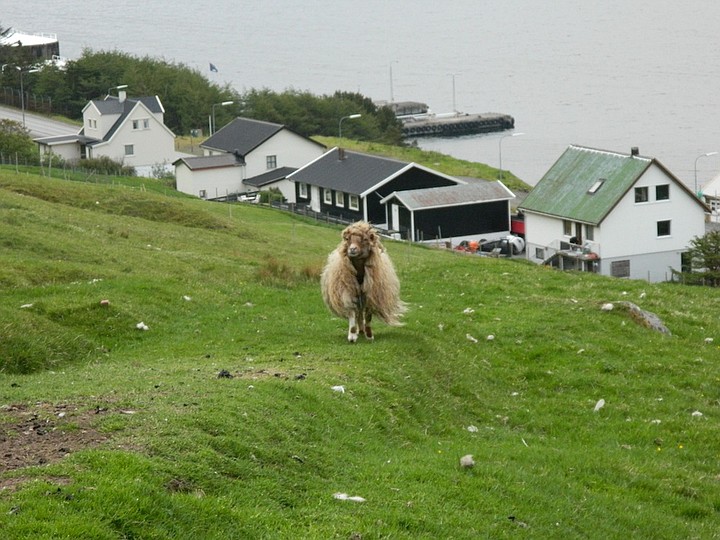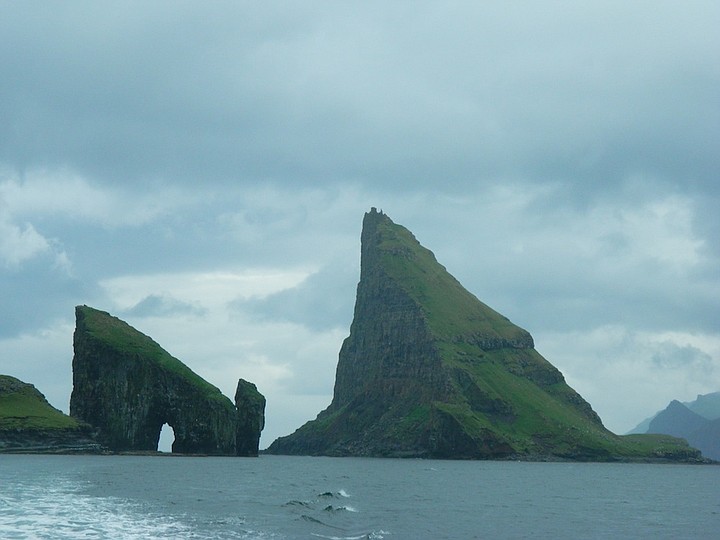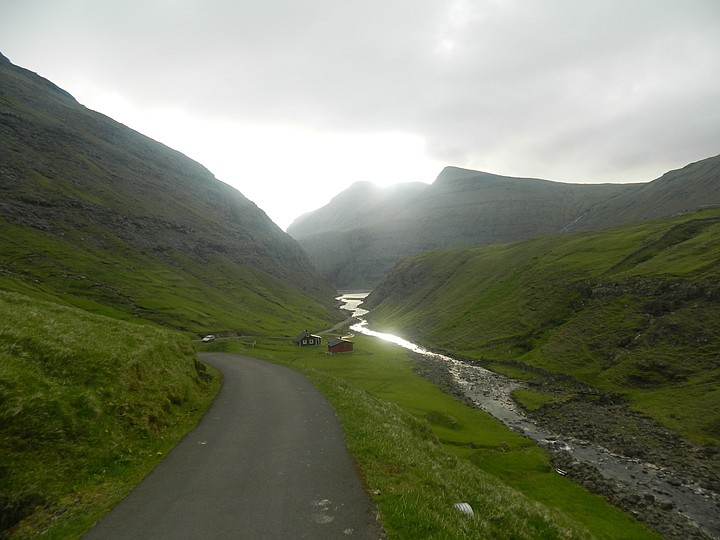 Facebook
Facebook
 X
X
 Instagram
Instagram
 TikTok
TikTok
 Youtube
Youtube

Most Americans probably don’t know where the Faroe Islands are. They’re a small island chain between Iceland and Scotland, speaking a language derived from Old Norse and Western Norwegian dialects.

If anyone's heard of the self-governing Nordic country within the Danish realm, it’s likely because of the confrontation locals had with Whale Wars’ Paul Watson over the killing of non-endangered pilot whales. These Viking descendants from Western Norway – as well as possibly Ireland and the Scottish islands – have been eating pilot whales for over 1,200 years. Paul Watson’s cultural arrogance infuriates my husband, so he decided we should go to the Faroe Islands and that I report on my findings.
How to get there. The Faroese national airline, Atlantic Airways, has direct flights from Nordic destinations including Reykjavik; London; and a couple of European “sunbelt” cities, Barcelona and Milan. Their airport has a decently sized duty-free shop, a café and to-go boxes from Etika, which bills itself as “the best sushi in the world.” Once onboard, little meals are served on the under-two-hour flight. The female flight attendants seem to be well over 6’ tall and are stunning enough to be high fashion models.

What to do. You’ll need – and want – a car to get around the handful of contiguous islands of the Faroes’ 18. While driving, you’ll come across some of the most amazing rock formations and scenery on the planet. Some areas don’t even look like our planet!
Driving involves renting a stick-shift car and minding two potential hazards: 1) The nearly 80,000 sheep that have free run of the land and know it. 2) Many of the main artery roads are single-laned, with little turnoffs every several yards to allow trucks to pass, even on precarious bluffs. Relax by listening to radio station Utvarpid FM 1, which seems to have a real college indie station–type playlist.

If you like rugged hiking and the possibility of spotting the famous puffin birds (left), take a ferry or helicopter to the western island of Mykines, pronounced “Meech-nes.” The boat ride can be on the rocky side, but I hear ferries to the southern islands (though reputedly very beautiful) are even more challenging.

A thousand years ago in Mykines, Vikings on one side of the ridge would climb over the ridge to visit the community on the other side for occasions like christenings, weddings and funerals. This is hiking the way it used to be: no trampled path, no paving stones, no handrail. I couldn’t make it all the way up the hill, let alone traipsing the ridge. If I had been invited to a Viking funeral, I’d have stayed back in my village – the guest of honor would be none the wiser.
The town only has about 20 homes and there’s no shopping. A hostel runs a teeny café, cash only. The ferry drops you off in the morning and picks you up in the late afternoon, so plan on hiking, come inevitable rain (or shine).
Sitting back in the States, sweltering in the summertime, it’s hard to imagine packing gloves and a warm hat for the Faroes’ wildly fluctuating temperatures. Just do it. Especially for trips out on the sea. Probably one of the coolest – figuratively – experiences I’ve ever had was taking the Norðlýsið schooner out of Torshavn to a concert in a grotto. You ride a real vintage schooner (take a Coke or Dramamine with you) out to a cave and then get in life rafts to enter the cave. Inside are musicians playing a concert with incredible acoustics and surroundings!

Right in the harbor where the schooner docks is the thrift store for Reyði Krossur Føroya – Faroese Red Cross. The Faroes are known for having some of the finest wool on Earth. In fact, Danish soldiers negotiated to get a Faroese sweater as part of their uniform. That was pretty smart of them; those sweaters run several hundred dollars. At the thrift store, maybe you’ll get lucky like I did and snag a handmade sweater for $10!
What to eat. What do the Faroese consider home cooking? Do they really eat whale? As it turns out, yes, they do... when they can get it. There’s a family – the Hansens – in Søldarfjørður that have a "home visit" for lunch or dinner. You make arrangements in advance; dinner works out to be about $50 US per person, cash in DKK. Contact Garðavegur 27, Søldarfjørður, Faroe Islands, (+298)217841 or [email protected].
There are a few restaurants in the world that people talk about buying tickets to: El Bulli (in the old days), Fat Duck, Noma and Per Se, for example, are destinations in themselves. I would add Koks to the "must-eat" world-class culinary list.
Located in the national capital of Torshavn, its cuisine is local, Nordic and often wild-harvested. It's very accessible: no pilot whale blubber that I could see. Presentation is super imaginative, incorporating lots of local materials and themes. Dried cod hangs outside, doing its drying thing in true Faroese tradition. They also have local beers and cider.

Where to stay. In the northern little village of Gjógv is the quaint hotel/rustic guesthouse Gjáargarður. Rooms are simple with clean design and Nordic amenities like extra comforters. They overlook the picturesque village and sea below. It’s perfect for a gathering of friends, family or business associates; their on-site restaurant and bar seems like a kitchen in someone's house. There’s an artisan gift shop on site.
Hotel Føroyar is just outside downtown Torshavn; its ability to ensure privacy may be one of the reasons Bill Clinton prefers it and has a suite named after him. All the rooms have a view of the capital and the North Atlantic... and they have Koks the restaurant!
For more information: visitfaroeislands.com.


Most Americans probably don’t know where the Faroe Islands are. They’re a small island chain between Iceland and Scotland, speaking a language derived from Old Norse and Western Norwegian dialects.

If anyone's heard of the self-governing Nordic country within the Danish realm, it’s likely because of the confrontation locals had with Whale Wars’ Paul Watson over the killing of non-endangered pilot whales. These Viking descendants from Western Norway – as well as possibly Ireland and the Scottish islands – have been eating pilot whales for over 1,200 years. Paul Watson’s cultural arrogance infuriates my husband, so he decided we should go to the Faroe Islands and that I report on my findings.
How to get there. The Faroese national airline, Atlantic Airways, has direct flights from Nordic destinations including Reykjavik; London; and a couple of European “sunbelt” cities, Barcelona and Milan. Their airport has a decently sized duty-free shop, a café and to-go boxes from Etika, which bills itself as “the best sushi in the world.” Once onboard, little meals are served on the under-two-hour flight. The female flight attendants seem to be well over 6’ tall and are stunning enough to be high fashion models.

What to do. You’ll need – and want – a car to get around the handful of contiguous islands of the Faroes’ 18. While driving, you’ll come across some of the most amazing rock formations and scenery on the planet. Some areas don’t even look like our planet!
Driving involves renting a stick-shift car and minding two potential hazards: 1) The nearly 80,000 sheep that have free run of the land and know it. 2) Many of the main artery roads are single-laned, with little turnoffs every several yards to allow trucks to pass, even on precarious bluffs. Relax by listening to radio station Utvarpid FM 1, which seems to have a real college indie station–type playlist.

If you like rugged hiking and the possibility of spotting the famous puffin birds (left), take a ferry or helicopter to the western island of Mykines, pronounced “Meech-nes.” The boat ride can be on the rocky side, but I hear ferries to the southern islands (though reputedly very beautiful) are even more challenging.

A thousand years ago in Mykines, Vikings on one side of the ridge would climb over the ridge to visit the community on the other side for occasions like christenings, weddings and funerals. This is hiking the way it used to be: no trampled path, no paving stones, no handrail. I couldn’t make it all the way up the hill, let alone traipsing the ridge. If I had been invited to a Viking funeral, I’d have stayed back in my village – the guest of honor would be none the wiser.
The town only has about 20 homes and there’s no shopping. A hostel runs a teeny café, cash only. The ferry drops you off in the morning and picks you up in the late afternoon, so plan on hiking, come inevitable rain (or shine).
Sitting back in the States, sweltering in the summertime, it’s hard to imagine packing gloves and a warm hat for the Faroes’ wildly fluctuating temperatures. Just do it. Especially for trips out on the sea. Probably one of the coolest – figuratively – experiences I’ve ever had was taking the Norðlýsið schooner out of Torshavn to a concert in a grotto. You ride a real vintage schooner (take a Coke or Dramamine with you) out to a cave and then get in life rafts to enter the cave. Inside are musicians playing a concert with incredible acoustics and surroundings!

Right in the harbor where the schooner docks is the thrift store for Reyði Krossur Føroya – Faroese Red Cross. The Faroes are known for having some of the finest wool on Earth. In fact, Danish soldiers negotiated to get a Faroese sweater as part of their uniform. That was pretty smart of them; those sweaters run several hundred dollars. At the thrift store, maybe you’ll get lucky like I did and snag a handmade sweater for $10!
What to eat. What do the Faroese consider home cooking? Do they really eat whale? As it turns out, yes, they do... when they can get it. There’s a family – the Hansens – in Søldarfjørður that have a "home visit" for lunch or dinner. You make arrangements in advance; dinner works out to be about $50 US per person, cash in DKK. Contact Garðavegur 27, Søldarfjørður, Faroe Islands, (+298)217841 or [email protected].
There are a few restaurants in the world that people talk about buying tickets to: El Bulli (in the old days), Fat Duck, Noma and Per Se, for example, are destinations in themselves. I would add Koks to the "must-eat" world-class culinary list.
Located in the national capital of Torshavn, its cuisine is local, Nordic and often wild-harvested. It's very accessible: no pilot whale blubber that I could see. Presentation is super imaginative, incorporating lots of local materials and themes. Dried cod hangs outside, doing its drying thing in true Faroese tradition. They also have local beers and cider.

Where to stay. In the northern little village of Gjógv is the quaint hotel/rustic guesthouse Gjáargarður. Rooms are simple with clean design and Nordic amenities like extra comforters. They overlook the picturesque village and sea below. It’s perfect for a gathering of friends, family or business associates; their on-site restaurant and bar seems like a kitchen in someone's house. There’s an artisan gift shop on site.
Hotel Føroyar is just outside downtown Torshavn; its ability to ensure privacy may be one of the reasons Bill Clinton prefers it and has a suite named after him. All the rooms have a view of the capital and the North Atlantic... and they have Koks the restaurant!
For more information: visitfaroeislands.com.
Comments